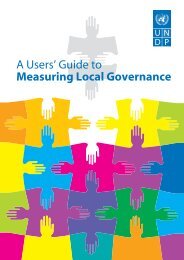planning a governance assessment - United Nations Development ...
planning a governance assessment - United Nations Development ...
planning a governance assessment - United Nations Development ...
Create successful ePaper yourself
Turn your PDF publications into a flip-book with our unique Google optimized e-Paper software.
Section<br />
8<br />
Sampling – The Basics<br />
Every survey research project needs a sampling strategy. This applies to both qualitative and quantitative research.<br />
Social scientists rely upon sampling to make inferences about a population.<br />
• The population is the entire group of elements about which we would like to know something.<br />
• A sample is a subset of these elements. Sometimes the researcher includes the entire population in the study,<br />
which is called a census.<br />
• Samples provide us with estimates of characteristics found in the population. Some estimates are better than others,<br />
and most estimates contain some error.<br />
• A sampling frame contains all the eligible elements for the study. Examples of sampling frames include a voters’ list,<br />
membership list, or telephone book.<br />
Two major types of sampling<br />
Probability sampling is also commonly referred to as random sampling. In this type of sampling, each element in the<br />
sampling frame has a known chance of ending up in the sample. Some of the major types in this category include Simple<br />
Random, Systematic Random, Stratified, Multistage and Cluster sampling.<br />
Non-probability sampling implies that personal judgment has somehow been involved in the decision about which<br />
elements to include in the sample. One cannot say before the fact what the chances are of any one element being included<br />
in the sample. The major types of non-probability (non-random) sampling include Purposive or Judgmental, Quota and<br />
Snowball sampling.<br />
Sample size and sampling error are related in probability-based samples. A poor sample can introduce error into results<br />
in many ways. One, the sampling error, is easy to understand and calculate. Sampling error is directly related to the size of<br />
the sample. It is the amount of error associated with the sample not representing the population on the measure of interest.<br />
It is important that one knows the sampling error, or as it is commonly referred to, the margin of error (MOE). In probability<br />
(i.e., random) samples, as sample size increase, the MOE decreases. Upon deciding on the amount of sampling error that one<br />
can accept, always remember that this type of error increases when examining sub-groups in the overall sample (i.e. by sex,<br />
age, education, regions).<br />
For populations of more than 1,000, there should be a sample size of at least 500. However, an overall sample size of 500<br />
restricts the ability to disaggregate the data and draw meaningful conclusions about factors such as sex, region, religion,<br />
ethnicity or vulnerable groups. Once these groups are broken out, the sample sizes will shrink, increasing the amount of<br />
sampling error associated with the results. Therefore, if possible, one should have a sample size of 500 for each group of<br />
interest in the population.<br />
28<br />
Planning a Governance Assessment: A Guide to Approaches, Costs and Benefits








![GuÃa del Usuario ] - Governance Assessment Portal](https://img.yumpu.com/44740603/1/190x253/gua-a-del-usuario-governance-assessment-portal.jpg?quality=85)







